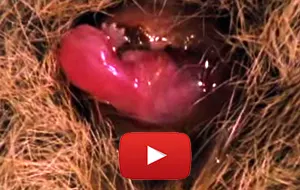Kangaroo Reproductive System Kangaroo Genitalia
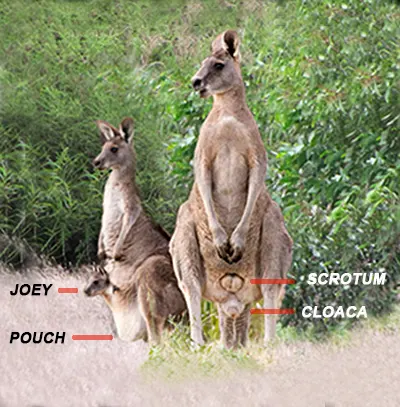
Photo: Kangaroo female with baby in pouch and male
Contents
Kangaroos have some unusual reproductive features. Female kangaroos have three vaginas, two uteruses, and carry their babies in a pouch. Male kangaroos have a long tapering penis located behind their scrotum. Both male and female kangaroos have a single opening called a cloaca, which serves as a shared intestinal, urinary, and genital tract. This single opening is similar to that in reptiles and birds. Also, male kangaroos do not have a pouch or nipples. And did you know—kangaroos don't have belly buttons (navels)!
Male Kangaroo Reproductive Anatomy
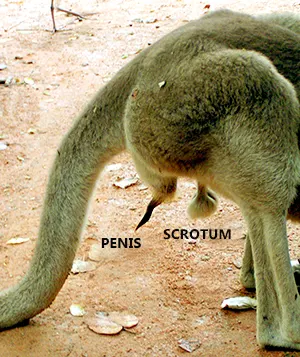
Photo: Male kangaroo penis and scrotum
Do Male Kangaroos have 2 Penises?
A male kangaroo does not have two penises! Instead, the male kangaroo has a single slender penis that is usually tucked away into a preputial sac inside its cloaca. When aroused, the erect penis (see photos) extends out of its cloaca and curves forward and upwards reaching a length of 18 to 25 centimetres (7 to 10 inches).
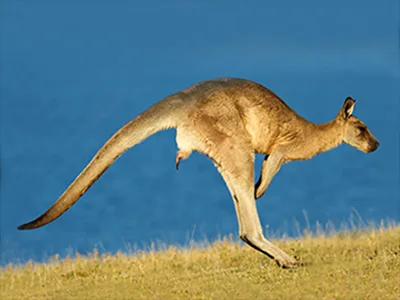
Photo: Male kangaroo penis visible while hopping
More Interesting Male Kangaroo Facts
• A male kangaroo’s penis is behind its scrotum. This unusual because most other mammals where the penis is in front of the scrotum.
• The male kangaroo has a pendulous scrotum that is retracted tightly against its body when hopping or engaging in sexual activity. In other words, its testicles (balls) usually hang under its body but are pulled up against its body when hopping or mating. This adaptation of a hanging scrotum is crucial for keeping the animal's testicles cooler than its core body temperature.
• Its body ceases sperm production during periods of severe drought to conserve energy.
Did You Know
A male kangaroo does not have a pouch or nipples and reaches sexual maturity at approximately 24 months. And contrary to another myth, kangaroos don't play with their balls. Instead, in extremely hot weather, the male kangaroo licks them to keep them cool.
Female Kangaroo Reproductive Anatomy
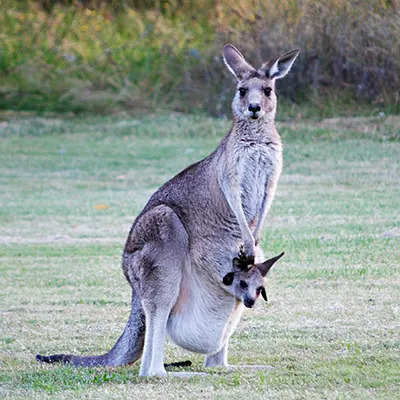
Photo: Female kangaroo with baby joey
Female Kangaroo's have 3 Vaginas and 2 Uteruses
• Three vaginas: The two outermost vaginas are used for sperm transportation to its two uteruses. And babies are born through the middle vagina. (See diagram). Female placental mammals, on the other hand, have only one uterus and one vagina.
• Two uteruses:
Each uterus is capable of housing a developing embryo independently.
Female Kangaroos Can be Continuously Pregnant
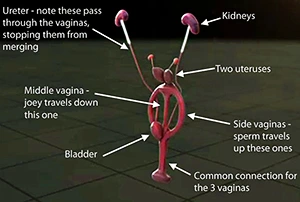
Diagram: Female kangaroo Reproductive System
With this unusual reproductive system, a female kangaroo can be continuously pregnant, with her babies at different stages of development:
• One fertilised egg in one uterus on hold, waiting to be released
• One baby growing in the other uterus
• One newborn in her pouch
• One
hopping outside but coming to its mother for milk.
So Why Do Kangaroos Have 3 Vaginas and 2 Uteruses?
The reasons why kangaroos have three vaginas and two uteruses may be a biological anachronism. Or it is because having babies in different stages of development gives these animals a reproductive advantage by allowing them to procreate rapidly in good times.
Female Kangaroo Can Practice Birth Control
Another unique feature is that the female kangaroo can practice birth control during drought and starvation by putting the babies growing in her uteruses 'on hold', stopping their future development until conditions improve. This is called embryonic diapause.
Do Kangaroos Have 3 Periods?
No, female kangaroos don't have three periods. In fact, kangaroos have no periods at all. Instead, female kangaroos have what's called "covert menstruation". In this type of mensuration, the extremely thin lining of the uterus is completely reabsorbed into the body at the end of each reproductive cycle. This hidden cycle helps reduce water loss — a critical adaptation in the dry Australian environment.
The Kangaroo's Pouch
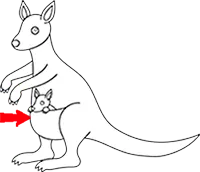
Photo: Baby in kangaroo pouch
Only female kangaroos have a pouch, which is located on the front of their body and acts as an external womb. This pouch provides a young kangaroo with food, warmth, shelter and protection as it grows. This is because a baby kangaroo is born tiny and underdeveloped and needs its mother's pouch to provide nourishment and protection while it grows into a viable offspring.
A kangaroo's pouch has a horizontal opening on top and is lined with muscles and ligaments that allow it to expand to accommodate the growing joey inside. The inside of a kangaroo's pouch is warm and nearly fur-less. The female kangaroo has four nipples that supply milk with different nutrient levels. In addition, the pouch is lined with sweat glands that release antimicrobial fluid to protect the joey from germs, viruses, and parasites.
The female kangaroo is not born with a pouch. Instead, her pouch develops as she begins to reach sexual maturity at around 16 months.
Kangaroo Mating Behaviour
How do Kangaroos Mate?
Kangaroos do not have a fixed breeding season, but mating typically increases when food is plentiful. Female kangaroos are generally receptive from late spring to early autumn.
When the female is sexually in heat, she will exhibit a particular behaviour signalling that she is receptive. An interested male will sniff her urine and approach her. It is common for a dominant male to drive off lesser rivals for mating rights by standing on his toes and tail tip, and making growling and clucking noises. If challenged, a fight will ensue. These fights rarely result in serious injury. The successful male will then approach the female, and if she is receptive to him, he will copulate with her. Copulation sessions can last up to 50 minutes. After copulation, the male will move on seeking other receptive females.
Kangaroo Eggs: Myth or Fact?
Kangaroos do not lay eggs. But, kangaroos do produce eggs encased in a very fine and fragile shell similar to that of birds and reptiles. This shell disintegrates by the time the embryo implants inside the uterine wall.
The gestation period for a kangaroo is approximately 30-36 days and varies amongst the different types of kangaroos. Females give birth to one offspring. (Twin births have been reported, but only one baby survives).
Kangaroo Life Cycle
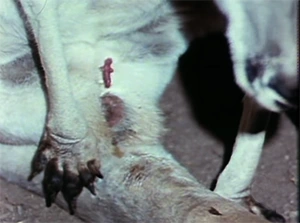
Photo: Kangaroo baby crawling to pouch
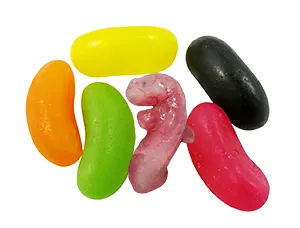
Photo: Kangaroo baby size compared to jelly beans
Birth Preparation
As birth approaches the female kangaroo cleans out its pouch by licking it thoroughly. It then takes up a "birthing position" by sitting on its back with its tail between its legs and the hind legs extended straight forward. It then licks its cloaca, possibly to stimulate the birth. It also licks its fur from its cloaca to the pouch opening, possibly as a path for the young joey to follow.
Birth of a Kangaroo Baby Joey
During birth, the young kangaroo breaks out of its amnion with its tiny, sharp claws and emerges from the birth canal.
The newborn kangaroo is called a joey and is no larger than a jelly-bean (2 cm or 0.79in). It weighs less than one gram (0.035oz). It is born blind, hairless, with stumpy forelimbs and hardly any trace of its hind legs. Even though it is still very underdeveloped, the young newborn has an excellent sense of direction, knowing which way is up and down and an acute sense of smell. Using its tiny forelimbs in a swimming motion, the young joey crawls laboriously up its mother's fur to the pouch. This journey takes about three minutes. The joey's journey is made entirely by itself. The mother does not assist it in any way. Once inside its mother's pouch, the joey quickly attaches itself to one of four nipples in the pouch.
Do Joeys Poop in the Pouch?
Yes! Baby kangaroos poop and pee inside the mother's pouch. But the female cleans out her pouch frequently by sticking her head into her pouch and licking out all dirt and muck.
Growth of the Young Kangaroo
Once it has attached itself to its mother's nipple, the young joey will stay hidden for up to six and a half months. Then, it will start to tentatively pop its head out of its mother's pouch and observe the world around it. About two weeks later, it will have gained enough confidence to venture out of the pouch and hop about close to its mother. However, if frightened, it will immediately jump back into the safety of the pouch. When it is about eight months old, the joey no longer uses its mother's pouch. It reaches sexual maturity at approximately 24 months.
Kangaroo Milk Production: Two Types of Milk
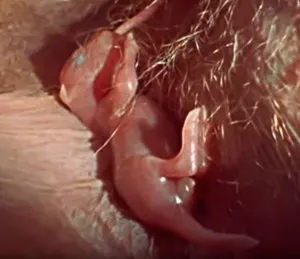
Photo: Kangaroo joey attached to mother's nipple
The female kangaroo can produce two types of milk, depending on the joey it is feeding. The milk produced in the nipple on which an embryonic joey is attached will be different from the milk produced to feed a joey that has already left the pouch and only comes back to be weaned.
Fun Historical Misunderstanding:
Because the young joey attaches itself so firmly onto its mother's nipple and is very difficult to pull away from it, early European explorers thought that baby kangaroos just miraculously grew off the nipple in the mother's pouch. This is because they couldn't see any opening inside the pouch from which the joey could have emerged. They didn't know about the little joey's perilous journey from the birthing canal to the pouch.
Other Amazing Australian Marsupials
Besides kangaroos, Australia is home to many other iconic marsupials, including:
• Koalas
• Wombats
• Wallabies
• Tasmanian devils
• Bandicoots
• Marsupial Mole
Each has its own fascinating reproductive adaptations suited to Australia's challenging environment.
